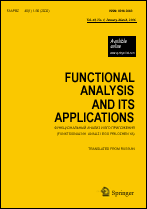|
This article is cited in 1 scientific paper (total in 1 paper)
Brief communications
On the discrete spectrum of the Hamiltonians of $n$-particle systems with $n\to\infty$ in function spaces with various permutation symmetries
G. M. Zhislinab
a N. I. Lobachevski State University of Nizhni Novgorod
b Scientific Research Institute of Radio Physics, Nizhnii Novgorod
Abstract:
The restrictions of the nonrelativistic energy operators $H_n$ of the relative motion of a system of $n$ identical particles with short-range interaction potentials to subspaces $M$ of functions with various permutation symmetries are considered. It is proved that, for each of these restrictions, there exists an infinite
increasing sequence of numbers $N_j$, $j=1,2,\dots$, such that the discrete spectrum of each operator $H_{N_j}$ on $M$ is nonempty. The family $\{M\}$ of considered subspaces is, apparently, close to maximal among those which can be handled by the existing methods of study.
Keywords:
many-particle Hamiltonian, discrete spectrum, permutation symmetry.
Received: 11.09.2013
Citation:
G. M. Zhislin, “On the discrete spectrum of the Hamiltonians of $n$-particle systems with $n\to\infty$ in function spaces with various permutation symmetries”, Funktsional. Anal. i Prilozhen., 49:2 (2015), 85–88; Funct. Anal. Appl., 49:2 (2015), 148–150
Linking options:
https://www.mathnet.ru/eng/faa3189https://doi.org/10.4213/faa3189 https://www.mathnet.ru/eng/faa/v49/i2/p85
|


| Statistics & downloads: |
| Abstract page: | 483 | | Full-text PDF : | 181 | | References: | 86 | | First page: | 28 |
|




 Contact us:
Contact us: Terms of Use
Terms of Use
 Registration to the website
Registration to the website Logotypes
Logotypes









 Citation in format
Citation in format 
